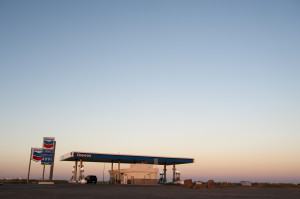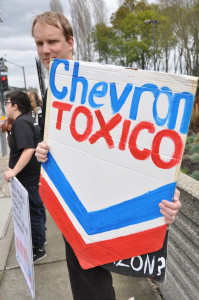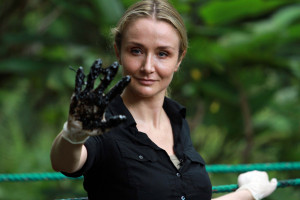Good Cause, Bad Lawyering: Chevron fights Ecuadorian judgment in the U.S. through genuine claims of fraud
Ecuadorian plaintiffs alleging environmental harms and private injuries against Chevron may have lost their only remedy through their lawyer’s fraudulent actions in Ecuador.
In a trial that began on October 15, 2013, Chevron Corporation (“Chevron”) is asking a federal court in New York to prevent Ecuadorian citizens and their lawyer from using American courts to enforce an Ecuadorean judgment ordering $8.6 billion in fines for environmental pollution. Although the Ecuadorian plaintiffs may have had a legitimate claim for environmental harms and private injuries, as well as a means of enforcement in the state of New York, their lawyer, Steven Donziger, likely disposed of their only remedy through fraudulent action in Ecuador.
The original lawsuit, which was filed in 2003, arose from claims of environmental contamination in an oil field in northeastern Ecuador. Between 1964 and 1992, a Texaco consortium (“Texaco”) had utilized the Amazonian location for oil drilling. Once discovered, Texaco paid $40 million to clean up its share of the contamination and—after signing agreements with Ecuador in order to ostensibly release itself from any further liability—turned the field over to state-owned Petroecuador in 1992.
The judgment awarded $8.646 billion in remediation damages and another $8.646 billion to be paid unless Chevron issued a “public apology” within fifteen days. Chevron never issued an apology.
Chevron never operated the drilling site in Ecuador, having inherited Texaco’s contamination only through acquisition of the company in 2001. It claims that Petroecuador was responsible for the majority of the pollution, which devastated a nearby village, Lago Agrio, and harmed the health of its villagers. Despite Texaco’s, and subsequently Chevron’s, release of liability from the Ecuadorian government, in 1999, Ecuador enacted the Environmental Management Act of 1999 (the “EMA”), which created a private right of action for Ecuadorians who had been individually affected to seek damages related to environmental harms to the community. The EMA thus became the basis for the litigation brought by the Lago Agrio villagers.
Well-known New York lawyer Steven Donziger brought a class action suit on behalf of the affected Lago Agrio villagers under the EMA. In February 2011, an Ecuadorean court awarded $18.2 billion to the plaintiff Ecuadorians, holding Chevron liable for the pollution. The judgment (pdf) awarded $8.646 billion in remediation damages and another $8.646 billion to be paid unless Chevron issued a “public apology” within fifteen days. Chevron never issued an apology. However, on November 12, 2013, the National Court of Justice, the highest court in Ecuador, affirmed the judgment but reduced the damages to $8.6 billion, eliminating the punitive damages that were imposed after Chevron refused to apologize for causing the pollution.
Donziger’s star has fallen, as he now faces racketeering and fraud charges of his own, and excerpts of the reverential documentary may prove to be damaging in the next trial.
Donziger became the face of the initial lawsuit, starring in an award-winning documentary, Crude, in which he was portrayed as the hero that brought justice to poor Ecuadorian natives whose lives were destroyed by oil drilling operations. His star has fallen, as he now faces racketeering and fraud charges of his own, and excerpts of the reverential documentary may prove to be damaging in the next trial.
Since the judgment was awarded, the Ecuadorian plaintiffs have been unable to collect damages in Ecuador because Chevron no longer has operations there. Further complicating matters, in 2011, Chevron obtained an injunction in New York blocking enforcement of the judgment anywhere outside of Ecuador, a harsh ruling that the Second Circuit Court of Appeals later reversed (pdf). Despite subsequently seeking enforcement of the judgment in Canada, Brazil, and Argentina, the plaintiffs have come up empty-handed in every jurisdiction.
Although there is currently no international or federal basis for enforcing judgments in the United States rendered by non-U.S. courts, the Ecuadorian plaintiffs do have a potential for redress in the American judicial system. Because the U.S. has not enacted any federal legislation, state law applies(pdf), even when the case is brought in U.S. federal court. In 1962, the National Conference of Commissioners on Uniform State Laws approved the Uniform Foreign Money-Judgment Recognition Act(pdf) (“UFMJRA”). Under UFMJRA, foreign judgments are enforceable—just as out-of-state judgments—unless the judgment fits into one of several enumerated exceptions.
Under UFMJRA, foreign judgments are enforceable—just as out-of-state judgments—unless the judgment fits into one of several enumerated exceptions.
There are both mandatory and discretionary grounds for such non-recognition of foreign judgments. Reasons for mandatory non-recognition include basic civil procedural and constitutional concerns, such as the foreign court’s lack of personal or subject matter jurisdiction; lack of impartiality; or failure to provide a party with due process of law. However, even if the non-U.S. court judgment meets all of these requirements, a U.S. court is not required to recognize the judgment under certain circumstances. One such discretionary ground for non-recognition pertinent to Chevron’s alleged claims against Donziger and the Ecuadorian plaintiffs includes any judgment obtained by fraud.
New York has traditionally been a generous forum in which to enforce judgments for money damages rendered by foreign courts. In 1970, New York adopted the UFMJRA as Civil Practice Law and Rules Article 53. Article 53 was designed to codify and elucidate existing case law on the subject as well as to promote the principle of comity—the efficient enforcement of New York judgments abroad by assuring foreign jurisdictions that their judgments would receive streamlined enforcement in the state of New York. In an action pursuant to Article 53, “the judgment creditor does not seek any new relief against the judgment debtor, but instead merely asks the court to perform its ministerial function of recognizing the foreign country money judgment and converting it into a New York judgment.” In line with the UFMJRA, New York has also adopted the discretionary non-recognition of judgments obtained through fraud.
In the American tribunal, Chevron primarily accuses both Donziger and the villagers of committing fraud. Although Chevron has also attacked the Ecuadorian judicial processes—claiming that its tribunals are not impartial and do not afford defendants with due process of law—in order to obtain mandatory non-recognition under the UFMJRA, case law illustrates that proof of the forum tribunal’s impartiality and compliance with due process is an easy standard to overcome.
For example, in S.C. Chemixem S.A. v. Velco Enterprises Ltd. (S.D.N.Y. 1999), a federal court in New York recognized a Romanian judgment even though corruption remained in Romanian courts and the judicial system was “far from perfect.” The court, proving that the prerequisite is truly minimal, recognized the judgment because it could not say that the Romanian judicial system was “as a whole devoid of due process.”
Ecuador’s judicial independence ranks in the top third (pdf) of judicial systems in Latin America and ranks equal to or better than fifty-five percent of the world. These facts, paired with the low standard for proof of impartiality and respect for due process, suggest that the outcome will more likely derive from the court’s discretionary determination of whether the judgment was obtained through fraud.
The party seeking non-recognition must show that the fraud “prevented the losing party from fully fairly presenting his case or defense” or otherwise significantly tainted the judicial process.
A party resisting enforcement of a foreign judgment bears the burden of proving that a discretionary statutory basis for non-recognition exists. As such, Chevron has the burden of proving the alleged fraud in the judgment’s procurement. In determining whether a litigant is entitled to relief from a prior judgment on the ground of fraud, courts consider whether:
- the fraud prevented a full and fair presentation of the litigant’s claim or defense in the prior action or otherwise would render it unconscionable to give effect to the prior judgment;
- the party seeking relief was diligent in discovering the fraud and attacking the judgment; and
- the evidence of the fraud is clear and convincing.
When courts consider whether to decline to recognize a prior judgment on the ground of fraud, a central question is whether such an outcome is appropriate to “protect the fairness and integrity of litigation.” A litigant making such a claim is not required to prove that the outcome of the prior case would have been different absent the fraud. Rather, the party must show only that the fraud “prevented the losing party from fully fairly presenting his case or defense” or otherwise significantly tainted the process.
According to Judge Lewis A. Kaplan, who will preside over the case in the Southern District of New York, this criterion also implies a “requirement of materiality, as judgments will not be set aside or denied recognition where the only impact of the misconduct or other taint is to prevent a litigant from presenting cumulative evidence, to deceive as to a peripheral issue, or the like.”
The court will determine whether the judgment was obtained through either extrinsic or intrinsic fraud, an important distinction regarding whether the grounds for non-recognition of the foreign judgment are mandatory or discretionary. “[T]he only type of fraud that may justify non-enforcement of an otherwise valid judgment of any court of competent jurisdiction, including a foreign court, is extrinsic fraud.”
Extrinsic fraud occurs when fraudulent conduct (pdf) by the prevailing party deprives “the losing party of an adequate opportunity to present its case to the court.” In other words, extrinsic fraud precludes the losing party from access to a fair and impartial trial. For example, bribing a judicial officer would be considered extrinsic fraud. Intrinsic fraud, alternatively, occurs when an intentionally false representation affects the legal claims at issue in the lawsuit.
Extrinsic fraud precludes the losing party from access to a fair and impartial trial. Intrinsic fraud, alternatively, occurs when an intentionally false representation affects the legal claims at issue in the lawsuit.
Chevron alleges four separate claims of fraud, to be summarized individually below:
The Alleged Ghost–Writing of the Judgment
Alberto Guerra, a former Ecuadorean judge, often wrote opinions for Judge Nicolas Zambrano, who issued the award to the villagers. Guerra said in a sworn deposition that Donziger pledged to pay Zambrano $500,000 from whatever they collected from the judgment in exchange for allowing them to write it. Guerra also said Zambrano promised to share part of the bribe. Corroborating evidence suggests that portions of the judgment were taken, word for word, from a plaintiff-side internal memo and that multiple authors composed the judgment. Donziger denies any wrongdoing. If substantiated, this would likely constitute extrinsic fraud.
The Calmbacher Reports
In 2004, the court ordered specific site inspections in order to assess the damages to the Ecuadorian village and surrounding areas. Each party was to select an expert to be present for the inspection, who would then submit a report containing his findings. Charles W. Calmbacher, one of the plaintiff’s experts for judicial inspections of the Lago Agrio site who was listed as the author of several reports, stated that the reports detailed conclusions and findings that he did not reach. This evidence is uncontradicted, as is Donziger’s statement in an email that “the lawyers might have to write” Calmbacher’s reports.
The Termination of Judicial Inspections and Cabrera’s Appointment
By 2006, the plaintiffs sought to dismiss the remaining judicial inspections and instead have a court-appointed, independent expert to prepare a global expert examination report, which would analyze environmental harm in the affected areas. Thus, the plaintiffs applied for termination of judicial inspections. During the pendency of the application, the plaintiff’s lawyers initiated several ex parte meetings in which they allegedly threatened to file a complaint against the judge, who had accumulated a risqué list of indiscretions, if he did not terminate the inspections and appoint Richard Stalin Cabrera Vega (“Cabrera”) to perform the global report.
The Cabrera and “Cleansing” Reports
Cabrera, who was allegedly appointed fraudulently in the first place, recommended billions in damages against Chevron. To make matters worse for the plaintiffs, evidence shows that the plaintiffs’ lawyers “secretly prepared [Cabrera’s ] work plan, worked closely with him in carrying it out, and drafted most of the report and its annexes.” Much of this information was evidenced in the Netflix version of the documentary Crude. Furthermore, the plaintiffs’ lawyers subsequently objected to the report publicly, stating that it was “unjustly favorable to Chevron” and that the damage estimate was too low. The cleansing reports, also allegedly procured by fraud, were used to calculate damages in the lawsuit.
Based on the uncontroverted and damaging evidence against the plaintiffs, which at least slightly compromised the judicial process, Chevron will probably avoid enforcement of the Ecuadorian judgment altogether.
It seems that Chevron may have a strong case for fraud against the plaintiffs, but much of the court’s decision depends on its classification of the fraudulent behavior as either extrinsic or intrinsic. If the court determines that the plaintiffs’ actions deprived Chevron of an adequate opportunity to present its case to the court, or significantly compromised the judicial process, Chevron will likely prevail in obtaining the court’s discretionary non-recognition of the Ecuadorian judgment. On the other hand, if the court deems the plaintiffs’ actions to be intrinsic fraud—or only affecting the underlying legal issues at trial—it will likely enforce the judgment against Chevron.
Based on the uncontroverted and damaging evidence against the plaintiffs, which at least slightly compromised the judicial process, Chevron will probably avoid enforcement of the Ecuadorian judgment altogether. Although this may seem like a harsh and saddening result for environmental activists, UFMJRA safeguards exist so that parties refrain from abusing systems of justice. Had Donziger and his legal team handled this case the right way, they would not have found themselves back in court.









